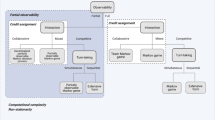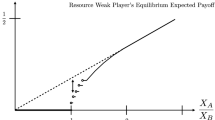Abstract
This study uses a multiagent system to determine which payment rule provides the most revenue in treasury auctions. The agents learn how to bid using straightforward bid adjustment rules that are based on impulse balance learning. The market model encompasses the when-issued, auction, and secondary markets, as well as bidding constraints for primary dealers. I find that when the number of primary bidders is less than 13 (Canada) the Discriminatory payment rule is revenue superior to the Uniform payment across most market price spreads. When the number of primary bidders is greater than 14 (United States), Uniform payment is revenue superior to Discriminatory payment for all market price spreads. In general, revenue increases with the minimum bid constraint and with the number of primary dealers for Uniform, Average, and Vickrey payment rules.
Similar content being viewed by others
References
Abbink K., Brandts J., Pezanis-Christou P. (2006) Auctions for government securities, a laboratory comparison of Uniform, Discriminatory, and Spanish designs. Journal of Economic Behavior & Organization 61: 284–303. doi:10.1016/j.jebo.2004.12.007
Arnone, M., & Iden, G.(2003). Primary dealers in government securities, policy issues and selected countries’ experiences (64 pp). IMF Working Paper 03/45.
Ausubel L. (2004) An efficient ascending-bid auction for multiple objects. The American Economic Review 94(5): 1452–1475. doi:10.1257/0002828043052330
Ausubel L. (2006) An efficient dynamic auction for heterogeneous commodities. The American Economic Review 96(3): 602–629. doi:10.1257/aer.96.3.602
Ayuso J., Repullo R. (2001) Why did the banks overbid? An empirical model of the fixed rate tenders of the European Central Bank. Journal of International Money and Finance 20: 857–870
Bank of Canada.(1998). Revised rules pertaining to auctions of Government of Canada securities and the Bank of Canada’s surveillance of the auction process (27 pp). Final Report.
Bank of Canada. (2005). Terms of participation in auctions for government securities distributors. Effective 13 December 2005.
Bartolini, L., & Cottarelli, C. (1997). Designing effective auctions for treasury securities (pp. 1–6). Current Issues in Economics and Finance 3, Federal Reserve Bank of New York.
Bikhchandani, S., Edsparr, P., & Huang, C. (2000). The treasury bill auction and the when issued market, some evidence (17 pp). UCLA Anderson Graduate School of Management Working Paper.
Chatterjea A., Jarrow R.A. (1998) Market manipulation, price bubbles, and a model of the U.S. Treasury securities auction market. Journal of Financial and Quantitative Analysis 33: 255–289. doi:10.2307/2331310
Daripa A. (2001) A theory of treasury auctions. Journal of International Money and Finance 20: 743–767. doi:10.1016/S0261-5606(01)00022-5
D’Souza, C., & Gaa, C. (2004). The effect of economic news on bond market liquidity (22 pp). Bank of Canada Working Paper 2004-16.
Dyer D., Kagel J.H., Levin D. (1989) A comparison of naïve and experienced bidders in common value offer auctions, a laboratory analysis. The Economic Journal 99: 108–115. doi:10.2307/2234207
Friedman M. (1963) Price determination in the United States treasury bill market: A comment. The Review of Economics and Statistics 45: 318–320
Garvin S., Kagel J.H. (1994) Learning in common value auctions, some initial observations. Journal of Economic Behavior & Organization 25: 351–372. doi:10.1016/0167-2681(94)90105-8
Goldreich D. (2007) Underpricing in discriminatory and uniform-price treasury auctions. Journal of Financial and Quantitative Analysis 42: 443–466
Government of Canada, Department of Finance. (2005). Debt management strategy 2005–2006. 33 pp.
Government of Canada, Department of Finance. (2006). Debt management strategy 2006–2007, 35 pp.
Government of Canada, Department of Finance. (2007). Debt management strategy 2007–2008, 18 pp.
Hortacsu, A., & Sareen, S.(2005). Order flow and the formation of dealer bids, information flows and strategic behavior in the Government of Canada securities auctions. NBER Working Paper, 11116, 51 pp.
Hutchinson J.C., Gigerenzer G. (2005) Simple heuristics and rules of thumb, where psychologists and behavioral biologists might meet. Behavioural Processes 69: 97–124. doi:10.1016/j.beproc.2005.02.019
Kagel J.H., Levin D. (1999) Common value auctions with insider information. Econometrica 67: 1219–1238. doi:10.1111/1468-0262.00074
Linzert T., Nautz D., Breitung J. (2006) Bidder behavior in central bank repo auctions, evidence from the Bundesbank. Journal of International Financial Markets, Institutions and Money 16: 215–230. doi:10.1016/j.intfin.2005.02.003
Lu, D., & Yang, J.(2003). Auction participation and market uncertainty, evidence from Canadian treasury auctions. In: Conference Paper Presented at the Canadian Economics Association 37th Annual Meeting, 21 pp.
Malvey, P. F., & Archibald, C. M. (1998). Uniform-price auctions, update of the treasury experience. U.S. Department of the Treasury, 19 pp.
Mehlenbacher, A. (2007a). Multiagent system platform for auction experiments. University of Victoria, Economics Department Discussion Paper, DDP0706.
Mehlenbacher, A. (2007b). Multiagent system simulations of sealed-bid auctions with two-dimensional value signals. University of Victoria, Economics Department Discussion Paper, DDP0707.
Mehlenbacher, A. (2007c). Multiagent system simulations of signal averaging in English auctions with two-dimensional value signals. University of Victoria, Economics Department Discussion Paper, DDP0708.
Merrick J.J., Naik N.Y., Yadav P.K. (2005) Strategic trading behavior and price distortion in a manipulated market, anatomy of a squeeze. Journal of Financial Economics 77: 171–218. doi:10.1016/j.jfineco.2004.10.004
Neugebauer T., Selten R. (2006) Individual behavior of first-price auctions: The importance of information feedback in computerized experimental markets. Games and Economic Behavior 54: 183–204. doi:10.1016/j.geb.2005.10.001
Nyborg K.G., Strebulaev I.A. (2004) Multiple unit auctions and short squeezes. Journal of Financial Studies 17(2): 545–580. doi:10.1093/rfs/hhg038
Nyborg K.G., Sundaresan S. (1996) Discriminatory versus Uniform treasury auctions, evidence from when-issued transactions. Journal of Financial Economics 42: 63–104. doi:10.1016/0304-405X(95)00871-B
Ockenfels, A.,&Selten, R. (2005). Impulse balance equilibrium and feedback in first price auctions. Games and Economic Behavior, 51, 155–170. doi: 10.1016/j.geb.2004.04.002
Ohtsubo Y., Rapoport A. (2006) Depth of reasoning in strategic form games. Journal of Socio- Economics 35: 31–47. doi:10.1016/j.socec.2005.12.003
Selten R., Abbink K., Cox R. (2005) Learning direction theory and the winner’s curse. Experimental Economics 8: 5–20
Selten, R., & Buchta, J. (1998). Experimental sealed bid first price auctions with directly observed bid functions. In D. V. Budescu, I. Erve, & R. Zwick (Eds.), Games and human behavior, essays (pp. 53–78). Lawrence Erlbaum Associates.
Smith V.L. (1968) Review of auctions and auctioneering by Ralph Cassady, Jr. The American Economic Review 58: 959–963
Swierzbinski, J.,&Borgers, T. (2004). The design of treasury bond auctions, some case studies. InM. C.W. Janssen (Ed.), Auctioning public assets, analysis and alternatives (pp. 230–256). Cambridge University Press.
U.S. Department of Treasury. http://www.treasurydirect.gov/instit/research/research.htm
Viswanathan S., Wang J.D. (2004) Inter-dealer trading in financial markets. Journal of Business 77: 987–1040. doi:10.1086/422631
Wang J.D., Zender J.F. (2002) Auctioning divisible goods. Economic Theory 19: 673–705. doi:10.1007/s001990100191
Author information
Authors and Affiliations
Corresponding author
Rights and permissions
About this article
Cite this article
Mehlenbacher, A. Multiagent System Simulations of Treasury Auctions. Comput Econ 34, 67–117 (2009). https://doi.org/10.1007/s10614-008-9165-z
Received:
Accepted:
Published:
Issue Date:
DOI: https://doi.org/10.1007/s10614-008-9165-z
Keywords
- Agent-based computational economics
- Multiagent systems
- Treasury auctions
- When-issued market
- Secondary market
- Primary dealers




